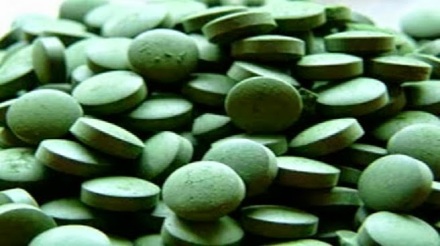One of the oldest life forms on Earth, spirulina is a blue-green microalgae that helped produce the oxygen in our atmosphere billions of years ago so that other life forms could appear. The original ‘superfood,’ spirulina is so nutrient dense that you could survive on it and water alone.
Hundreds of studies have confirmed spirulina’s powerhouse status. It has 60-70% complete protein, meaning it has all 8 essential amino acids and 10 non-essential ones that support good health. That’s more protein than beef, chicken or soybeans.
According to Balch, it contains concentrations of nutrients “unlike any other single grain, herb, or plant.” Some of its other valuable components include: gamma-linolenic acid (GLA), linoleic acid, arachidonic acid, vitamin B12, iron, nucleic acids RNA & DNA, chlorophyll and phycocyanin, which is found only in blue-green algae and has been shown to increase survival rates in mice with liver cancer (Balch).
Spirulina is highly digestible, protects the immune system, aids in mineral absorption and reduces cholesterol. Originally from warm alkaline lakes in Africa and Central and South America, spirulina was consumed by Aborigines of those places (including the Aztecs) for centuries, verifying its safety and healthful effects on the body.
Why take it? In his book Eat to Live, Dr. Joel Fuhrman talks about the importance of eating nutrient-rich foods to maintain healthy weight, avoid or correct chronic and degenerative disease and maximize longevity. Spirulina is perhaps the most nutritious food source known to humans and has been used all over the world for centuries for both its nutritional density and its medicinal qualities. Spirulina is a source of vitality and life energy. Consumers of spirulina usually notice an increase in energy and overall health.
It supplies nutrients needed to cleanse and heal while providing protection from all kinds of cancers as well as multiple viruses including influenza, herpes, mumps, measles and AIDS. It’s common knowledge that we should all eat fish for the omega fatty acid content. Where do fish get their high omega content? Blue-green algae like spirulina.
Omegas are essential in fighting heart disease, reducing arthritis, osteoporosis, diabetes, and depression as well as lowering bad cholesterol. The high content of vitamin B12 makes it excellent for the development of healthy nerve tissue and the metabolism of every cell in the body. This means spirulina helps with nerve damage and diseases such as fibromyalgia. Spirulina is also known for its high content of beta carotene, which is converted into vitamin A, an essential nutrient needed for healthy immunity, teeth, bones, mucous membranes, skin and eyes. Spirulina also contains all the other B vitamins, vitamin D, vitamin K, vitamin E, calcium, chromium, copper, iodine, magnesium, phosphorus, potassium, selenium and zinc. It has various antioxidants, phytonutrients and carotenoids.
It protects the brain and detoxifies the liver and kidneys. It balances pH to reduce inflammation, the root of much disease. It balances the immune system, including calming an overactive one, which is significant because overactive (or inflamed) immune systems are responsible for autoimmune diseases. These usually have their root in poor nutrition and digestion, which spirulina also helps correct. Additional Benefits Its superfood status means spirulina has many more benefits.
It increases antioxidant protection, fights free radicals, fights the aging process, curbs appetite and promotes weight loss, supports health cardiovascular function, improves the digestion process and gastrointestinal health, creates beneficial flora in the digestive tract and makes the body produce more red and white blood cells which kill germs and viruses. Spirulina’s antimicrobial effects help control the growth of pathogenic bacteria and yeasts. The chlorophyl means it is a blood cleanser. It also oxygenates the blood. Polysaccharides improve the functionality of bone marrow, thymus, and spleen cells.
Spirulina is good for the skin too: it improves age spots, eczema, acne and rashes. It’s good for the eyes as well, helping with glaucoma, cataracts and poor vision. Studies have shown that spirulina improves allergies and respiratory function and enhances exercise performance. Balch says taking spirulina between meals is beneficial for hypoglycemics because the high protein content stabilizes blood sugar levels.
How to get it in your diet Spirulina is named for the spiraling shape it makes as it grows. It grows best in warm, fresh water lakes, but is also found in saltwater and natural springs. It is what gives bodies of water their dark green color. It is harvested and turned into a thick paste, dried, and packed into powder or flakes to be turned into tablets or capsules. It is highly digestible and does not have the tough cell wall that others algae have. Most find the taste unpleasant. You can get flakes to add to food or smoothies, but most prefer to take it as a supplement, in pill form. Other things you should know Spirulina is one of the main go-to foods for protection from harmful radiation.
It protects the organs and helps detoxify the radiation out of the body. It was used to treat the children of Chernobyl. Spirulina has no side effects; it is very safe. It does contain iodine, to which some may be allergic. If you haven’t detoxed in awhile, add it to your regime slowly or you may experience the ill effects of detoxing. Some of it is wild harvested and tested for safety and purity while other is farmed to control environmental contaminates. Research the brand you choose or ask a qualified supplement consultant at a health food store. It is inexpensive, easy to find and it stores well. It is a great addition to your diet (as well as your disaster kit) so stock up!










